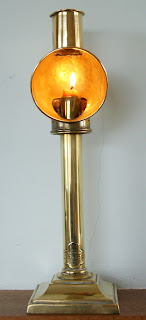 I have been reading At Day’s Close by A. Roger Ekirch, a fascinating review of what night meant for people from the middle ages to the late 18th century, a period when the small light man could produce served only to emphasis the darkness beyond.
I have been reading At Day’s Close by A. Roger Ekirch, a fascinating review of what night meant for people from the middle ages to the late 18th century, a period when the small light man could produce served only to emphasis the darkness beyond.Social life required a close eye on the phases of the moon to light you home at night, although in those days without light pollution starlight, when it was cloudless, served almost as well as moonlight.
In the home there was the light from the fire and candles, rush lights and oil lamps. Good candles were expensive – a job “not worth the candle” is one where the labour and the light outweighed the money that could be earned from it. But if one was set on extravagance you would “burn the candle at both ends.”
Beeswax candles were the most expensive. They smelled pleasant, they produced a good clear light and burning them was a sign of a well-to-do household. But even in the best homes it was considered wildly extravagant to allow the servants wax candles. Domestic staff and just about everyone else used tallow candles made from animal fat. The most common mix was mutton fat with some beef tallow. Candle-making was an autumn task, coinciding with slaughtering animals for the winter with plentiful supplies of fat to be rendered down.
Tallow candles stank of the fat they were made of and contained impurities which would stink and splutter. They needed constant attention and careful trimming of the wicks otherwise charred bits of wick, charmingly known as “snot”, would blow about and be a fire hazard.
Candles were sometimes taxed, especially during the 18th century and at times it was even illegal to make your own and avoid the tax.
If you could not afford even tallow candles you made do with rushlights. A rush would be dried and the peeled leaving just one thin strip along the length to reinforce it. The pithy core was then dipped time and again into kitchen fat and allowed to harden after each dipping until enough built up. Gilbert White the naturalist observed of one country housewife that “she obtains all her fat for nothing, for she saves the scummings of her bacon pot for this use.”
Even very frugal middle class homes would use some rushlights although they gave little light and burned relatively fast.
Oil lamps were less common in Britain than in continental Europe because there were fewer sources of vegetable and nut oils and the colder weather made the oil congeal in winter, but in the far north fish and birds oils were used and gradually the rose-coloured spermaceti oil from whales was availanble more widely.
It was considered the height of extravagance to use artificial light unless it was absolutely necessary. Some tasks such as knitting could be done virtually in the dark and women would gather in each others homes to share light and heat and gossip while they worked on mending, knitting or spinning – a habit that men mistrusted in case their wives were gossiping about them!
 The gloom in even a quite lavishly-lit room seems very pronounced to modern eyes. Some National Trust houses are experimenting with it in a few rooms with the guides warning visitors to stand still for a few moments while their eyes adjust.
The gloom in even a quite lavishly-lit room seems very pronounced to modern eyes. Some National Trust houses are experimenting with it in a few rooms with the guides warning visitors to stand still for a few moments while their eyes adjust.Candles burned at face height for those sitting so that wicks would easily be tended to and the light gave most help to the work in hand, or to cards or dice if games were being played. Cheating at cards, dalliance in dark corners and even a little “footsie” under the table could occur much more easily in these dim conditions.
In the 19thc more specialist lamps and lights began to appear, even before the advent of gas light in the home. The photograph is of a work lamp which is lit by a candle which rises up the column, pushed by a spring. The light is reflected off the polished brass of the inside of the hood and, during power cuts I find it quite sufficient to read by. A glass globe full of water placed between the candle and the person working was also used to magnify the light.
And finally one had to light oneself to bed, although servants were routinely forbidden candles in their bedchambers because of the fire risk. The fashionable young lady at the top of this post is making her way to bed is from an Ackermann print of 1823.
Louise Allen










